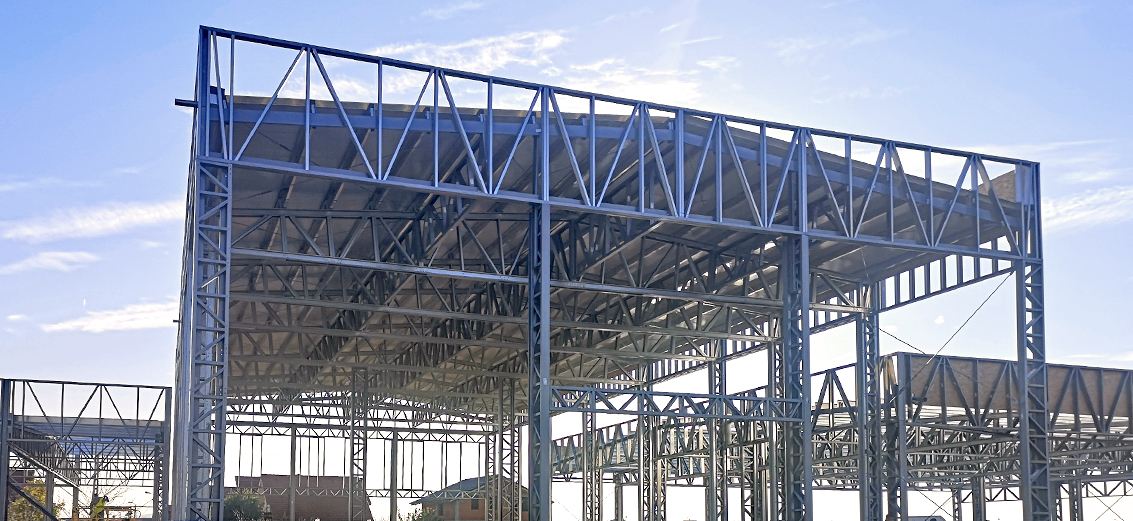Warehouse & distribution steel building project
A warehouse and distribution steel building project involves designing and constructing facilities specifically tailored for storage, logistics, and distribution operations using steel as the primary building material. These buildings play a crucial role in supporting supply chains, managing inventory, and facilitating efficient distribution of goods across various industries. Steel offers several advantages that make it well-suited for warehouse and distribution applications, including strength, durability, flexibility, cost-effectiveness, and sustainability.

Considerations for Warehouse & Distribution Steel Building Projects:
1. Strength and Durability:
o Steel provides robust structural integrity, capable of supporting heavy loads from stored goods, equipment, and machinery. It offers resistance to environmental factors such as wind, seismic activity, and moisture, ensuring long-term durability and reliability.
2. Design Flexibility:
o Steel allows for versatile architectural designs and configurations, accommodating specific warehouse and distribution needs. Buildings can include high bay storage areas, loading docks, mezzanine floors, office spaces, and temperature-controlled zones for perishable goods or sensitive materials.
3. Cost-Effectiveness:
o Steel buildings are often more cost-effective than traditional construction materials like concrete or masonry. They offer faster construction times, reduced maintenance expenses, lower insurance premiums due to fire resistance, and potential tax incentives for energy-efficient designs.
4. Customization Options:
o Warehouse and distribution steel buildings can be customized with features such as clear spans for efficient storage layouts, insulated panels for climate control, integrated racking systems, and automated conveyor systems for streamlined operations.
5. Energy Efficiency:
o Steel structures can integrate energy-efficient systems such as insulation, cool roofing materials, LED lighting, and advanced HVAC systems. This improves thermal performance, reduces energy consumption, and supports sustainability goals in warehouse operations.
6. Safety and Security:
o Steel buildings can incorporate safety features such as fire-resistant materials, sprinkler systems, secure access points, surveillance cameras, and alarm systems to protect stored goods and ensure employee safety.
7. Adaptability and Scalability:
o Steel buildings facilitate easy adaptation and scalability as warehouse and distribution needs evolve. They allow for expansions, additions of mezzanine levels, and modifications to accommodate changing inventory volumes, new technologies, or operational processes.
8. Environmental Sustainability:
o Steel is a sustainable building material with high recyclability and minimal environmental impact. Warehouse and distribution steel buildings contribute to green building certifications, reduce construction waste, and support resource-efficient logistics operations.
Applications of Warehouse & Distribution Steel Buildings:
• Distribution Centers: Large-scale facilities for receiving, storing, and shipping goods to retail outlets or customers.
• Cold Storage Warehouses: Temperature-controlled facilities for perishable goods, pharmaceuticals, and food products.
• E-commerce Fulfillment Centers: Facilities equipped with automation and robotics for order processing and distribution in the e-commerce industry.
• Cross-Docking Facilities: Logistics hubs for transferring goods directly from inbound to outbound transportation without long-term storage.
• Steel-framed building with high ceilings and clear spans to maximize storage capacity and operational efficiency.
• Climate-controlled zones with insulated panels and HVAC systems for temperature-sensitive inventory storage.
• Integrated loading docks, conveyor systems, and automated material handling equipment for efficient goods flow and order fulfillment.
• Sustainable design elements such as solar panels, rainwater harvesting systems, and energy-efficient lighting to minimize environmental impact and operational costs.
Choosing a Steel Building Provider:
• Expertise and Experience: Select a reputable steel building provider with specialized knowledge in warehouse and distribution center construction.
• Collaborative Design Process: Work closely with architects, engineers, and logistics specialists to develop customized designs that optimize space utilization, operational workflows, and logistics efficiency.
• Quality Assurance: Ensure the provider adheres to industry standards, safety protocols, and sustainability guidelines throughout the project lifecycle, including compliance with building codes and logistics regulations.




